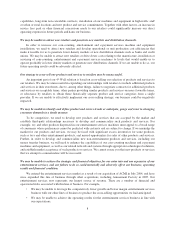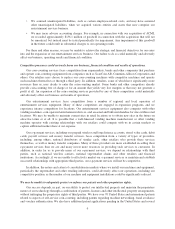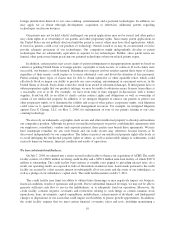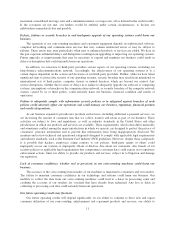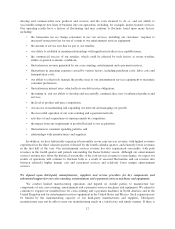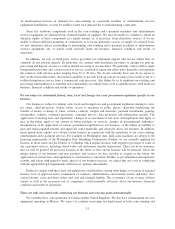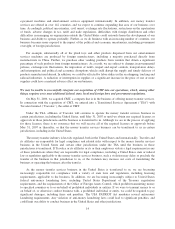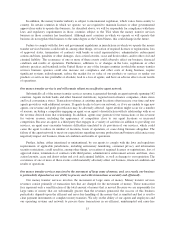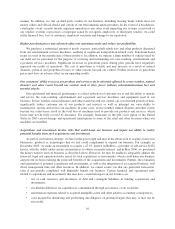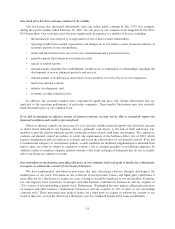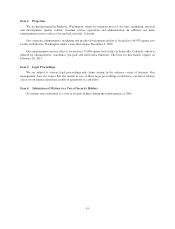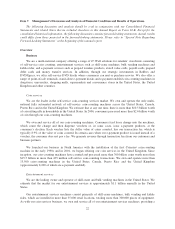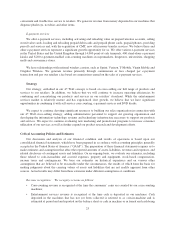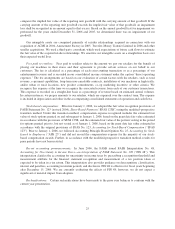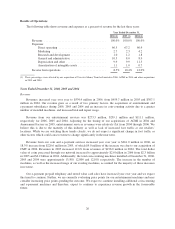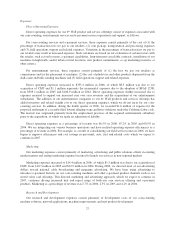Redbox 2006 Annual Report Download - page 20
Download and view the complete annual report
Please find page 20 of the 2006 Redbox annual report below. You can navigate through the pages in the report by either clicking on the pages listed below, or by using the keyword search tool below to find specific information within the annual report.Our stock price has been and may continue to be volatile.
Our stock price has fluctuated substantially since our initial public offering in July 1997. For example,
during the twelve months ended February 16, 2007, the sale price of our common stock ranged from $21.60 to
$34.40 per share. Our stock price may fluctuate significantly in response to a number of factors, including:
• the termination, non-renewal or re-negotiation of one or more retailer relationships,
• operating results below market expectations and changes in, or our failure to meet, financial estimates of
securities analysts or our own guidance,
• trends and fluctuations in the use of our coin, entertainment and e-payment services,
• period-to-period fluctuations in our financial results,
• release of analyst reports,
• announcements regarding the establishment, modification or termination of relationships regarding the
development of new or enhanced products and services,
• announcements of technological innovations or new products or services by us or our competitors,
• ineffective internal controls,
• industry developments, and
• economic or other external factors.
In addition, the securities markets have experienced significant price and volume fluctuations that are
unrelated to the operating performance of particular companies. These market fluctuations may also seriously
harm the market price of our common stock.
If we fail to maintain an effective system of internal controls, we may not be able to accurately report our
financial condition and results or prevent fraud.
Effective internal controls are necessary for us to provide reliable financial reports and effectively prevent
or detect fraud. Inherent in our business, which is primarily cash driven, is the risk of theft and fraud. Any
inability to provide reliable financial reports or prevent or detect fraud could harm our business. We continue to
evaluate our internal control procedures to satisfy the requirements of the Sarbanes-Oxley Act of 2002, which
requires management and our auditors to evaluate and assess the effectiveness of our internal controls. If we fail
to maintain the adequacy of our internal controls, as such standards are modified, supplemented or amended from
time to time, we could be subject to regulatory scrutiny, civil or criminal penalties or stockholder litigation. In
addition, failure to maintain adequate internal controls could result in financial statements that do not accurately
reflect our financial condition or results.
Our anti-takeover mechanisms may affect the price of our common stock and make it harder for a third party
to acquire us without the consent of our board of directors.
We have implemented anti-takeover provisions that may discourage takeover attempts and depress the
market price of our stock. Provisions in our certificate of incorporation, bylaws and rights plan could make it
more difficult for a third party to acquire us, even if doing so would be beneficial to our stockholders. Delaware
law also imposes some restrictions on mergers and other business combinations between us and any acquirer of
15% or more of our outstanding common stock. Furthermore, Washington law may impose additional restrictions
on mergers and other business combinations between us and any acquirer of 10% or more of our outstanding
common stock. These provisions may make it harder for a third party to acquire us without the consent of our
board of directors, even if the offer from a third party may be considered beneficial by some stockholders.
18


